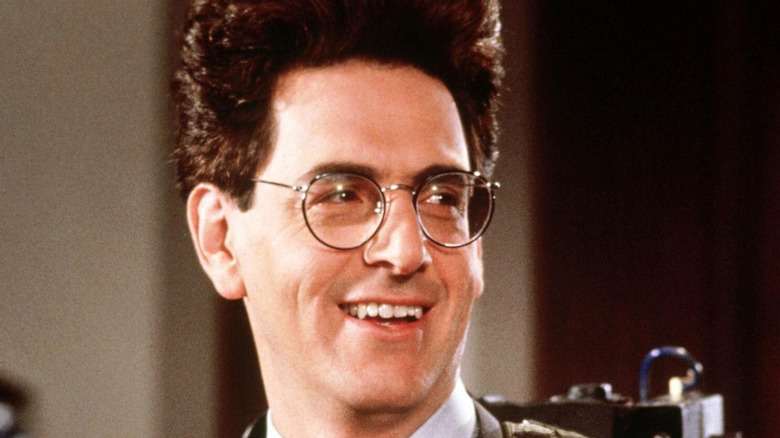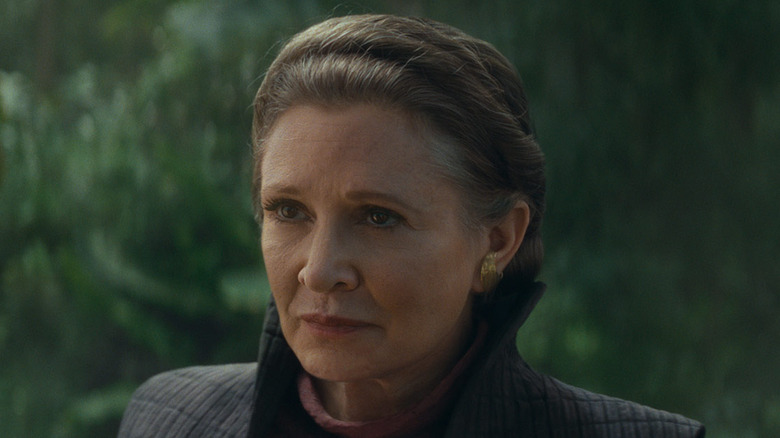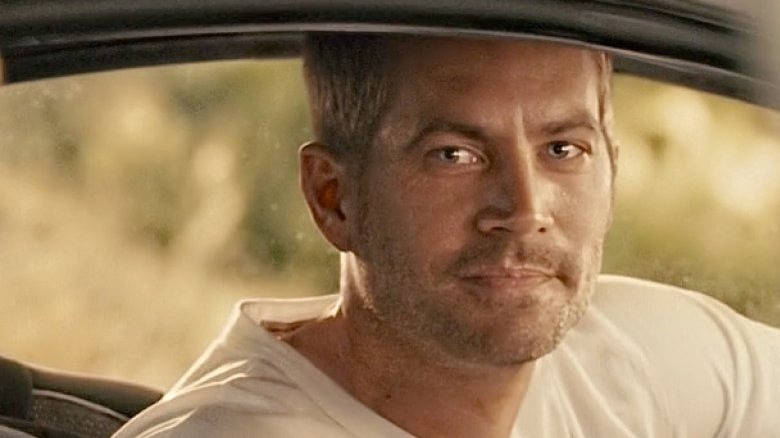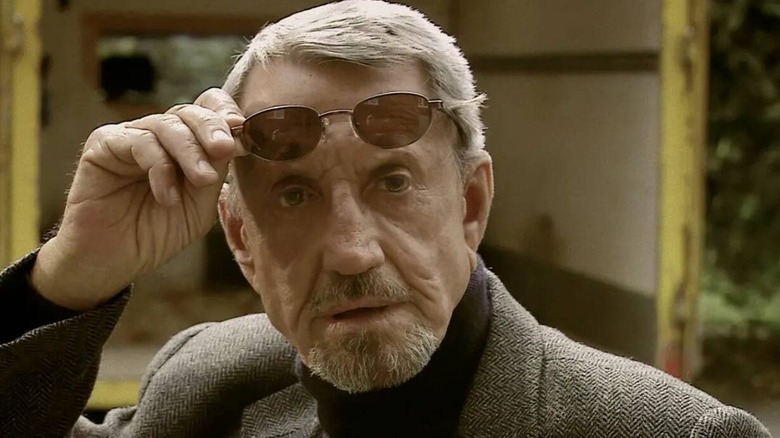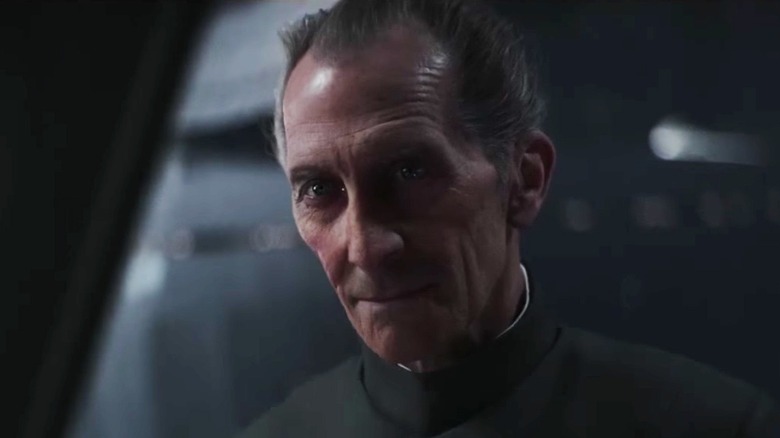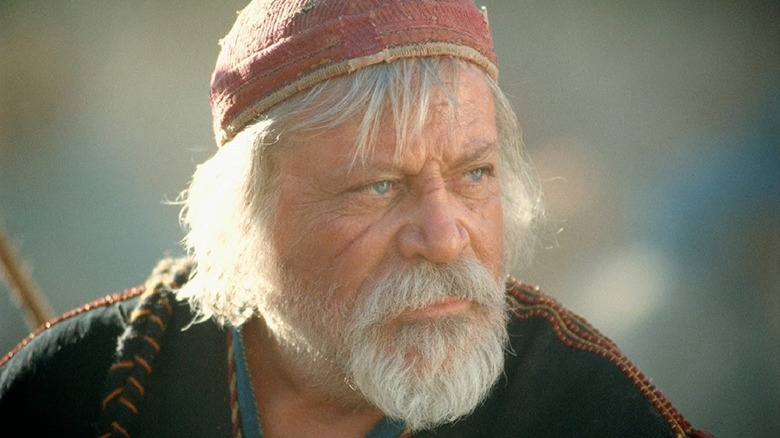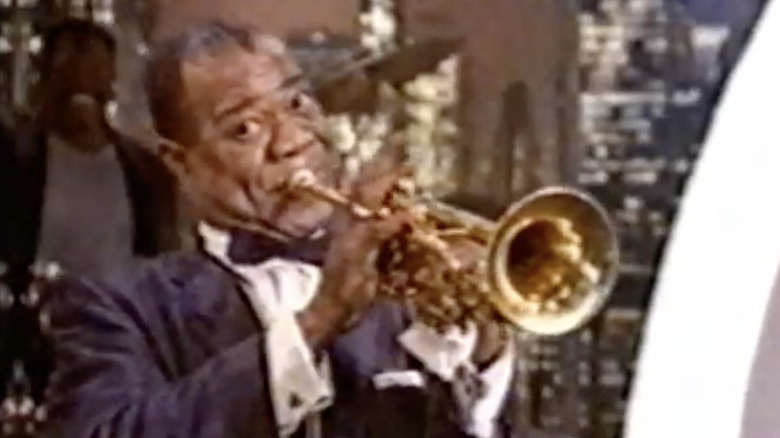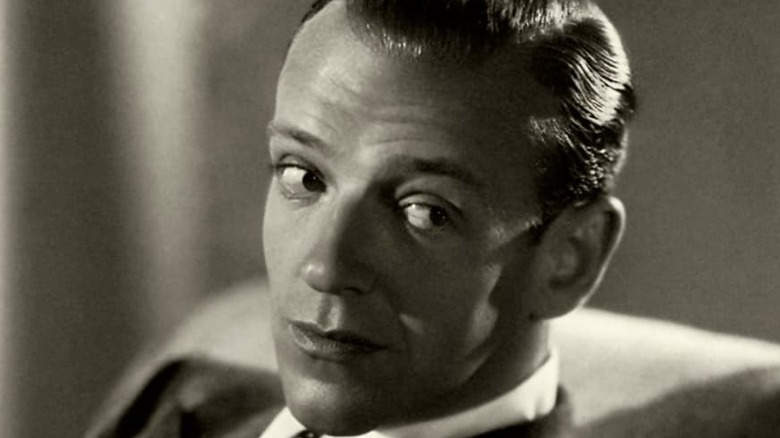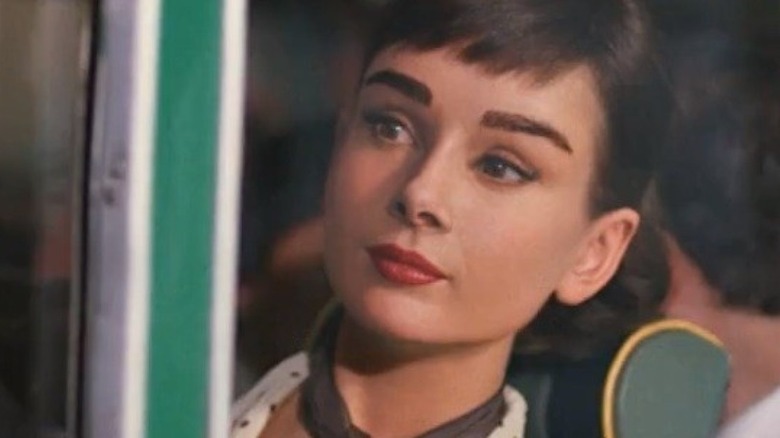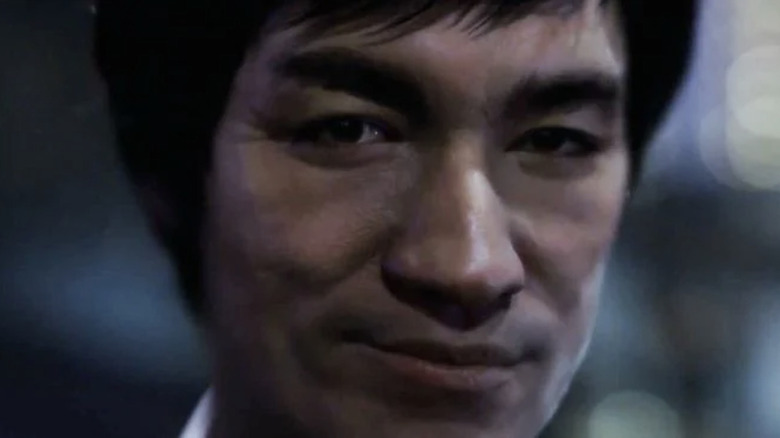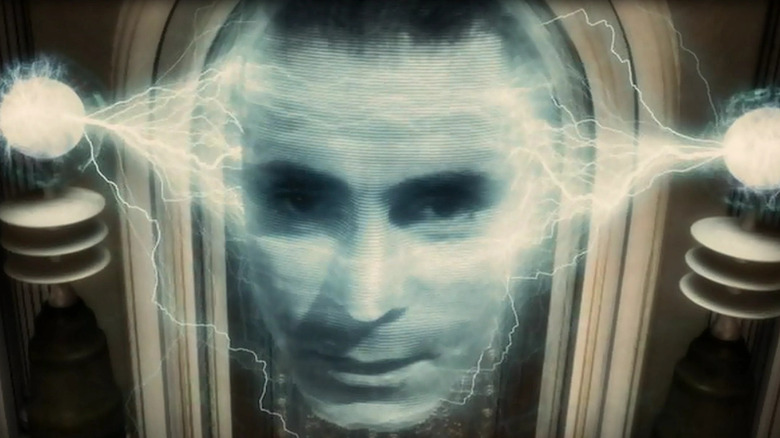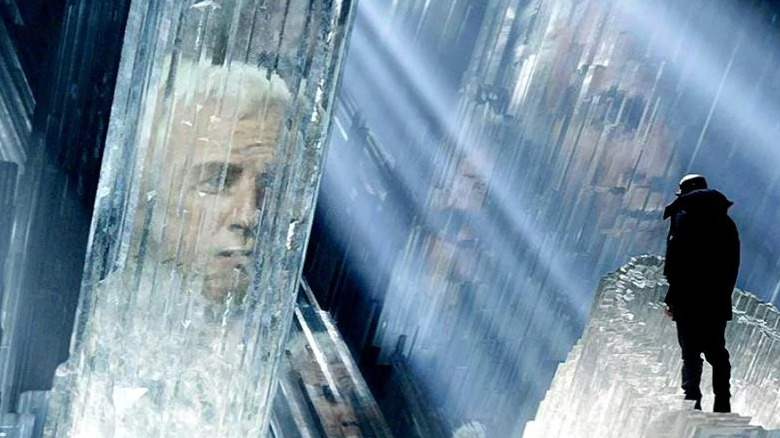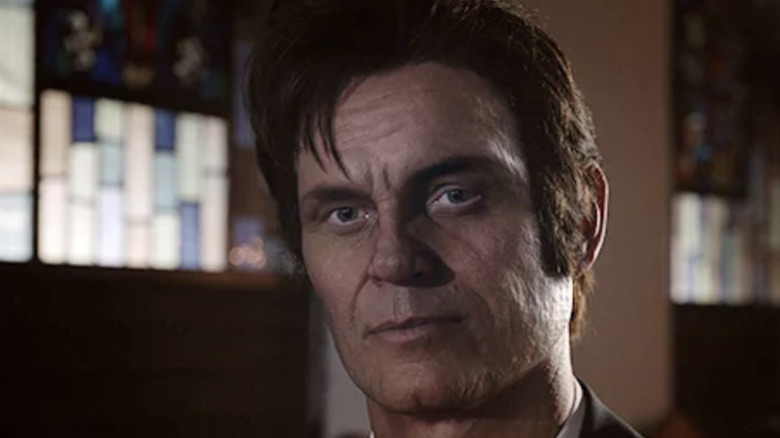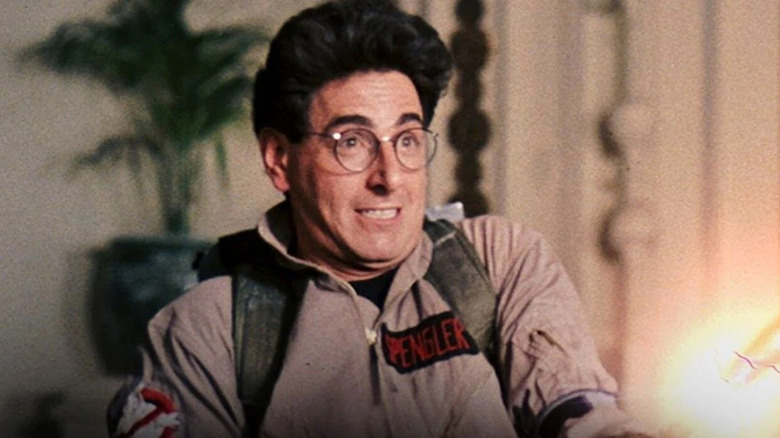Actors Who Were Brought Back From The Dead With CGI
Hollywood has been using all manner of movie-making illusions to resurrect deceased actors for almost as long as cinema has existed. As early as 1939, director Ed Wood wrote an entire film around unrelated footage that deceased "Dracula" star Bela Lugosi shot before his death ("Plan 9 From Outer Space," often called the world's "worst movie ever"). Cut together into an entirely different story, Wood accomplished the trickery with footage of non-actor Tom Mason, who covered his face with a cape so audiences might be convinced it was Lugosi's character. No actual special effects were used, but it was an early case of a director using clever tricks to create a new role for a dead star to add a big name to his fledgling picture.
Since then, advanced techniques have offered new, more convincing ways for studios and directors to bring back actors who've left us. Whether it's to complete a performance of an actor who died during filming, pay homage to a revered legend, or shamelessly cash in on an actor's fame, modern computer-generated special effects have given rise to some exciting — and troubling — instances of actors coming back long after they've shuffled off the mortal coil. Check out our list of actors who were brought back from the dead with CGI.
Carrie Fisher
While Princess Leia returned via CGI for the prequel film "Star Wars: Rogue One," which was released within days of actress Carrie Fisher's death, it doesn't really qualify as a post-mortem comeback, since it was created before her passing and the actress was said to have watched the scene herself before it was released. Her appearance in "Star Wars Episode IX: The Rise of Skywalker" three years later is another matter, as it included flashbacks of a younger Leia and an older Carrie Fisher in new scenes. Though some might have assumed that the film simply repurposed unused footage from "The Last Jedi" or "The Force Awakens" unaltered, an interview with VFX supervisor Roger Guyett shed new light on the Leia's return, revealing that CGI was involved.
"When you see Carrie in 'Episode IX,' it's a live-action face with a digital hair, head, and body," Guyett said. For flashback scenes that involved no dialogue, Lucasfilm dug into their archives and found dailies from "Return of the Jedi." Still, while most of the character was CGI, Guyett was quick to dispel any notion that VFX created a new performance, saying, "when you see her in the movie and you're looking at her face, that's her performance, and it's just the rest that's like a magic trick."
Paul Walker
From Marilyn Monroe in "Something's Got to Give" to Heath Ledger in "The Imaginarium of Doctor Parnassus," the tragic death of a film star during a movie's production is sadly not new to Hollywood. In Monroe's case, the studio opted to abandon the film entirely, while "The Imaginarium of Doctor Parnassus" found a way to add other actors to the film to fill in the gaps so that director Terry Gilliam could avoid replacing the actor with special effects. That movie's fantasy premise lent itself to that route, but not all films have that option.
When Paul Walker died in a car crash before being able to complete his part in "Fast & Furious 7," Universal Studios chose the CGI route in order to finish the film and round out the story of scrupulous FBI agent turned nefarious car thief Brian O'Connor. Unfortunately, much of Walker's role was incomplete, so the film had to be heavily rewritten to work around scenes that could no longer be filmed with Walker gone. To create newly written scenes that tied up the story for his character, Walker's real-life brother stood in for the actor. Advanced digital trickery was then used to recreate Paul Walker's face over his brother's body performance, as a way of giving the actor — and his character — a fitting sendoff in a touching tribute.
Roy Scheider
In another case of an actor's untimely death, veteran thespian Roy Scheider — perhaps best known for his role in Steven Spielberg's monster movie "Jaws" — was making the film "Iron Cross" (also known as "Beautiful Blue Eyes") when he died in 2008 from complications from multiple myeloma, after a four-year battle with the disease. The film chronicles an NYPD officer's attempts to seek revenge on the SS officer who killed his family during the Holocaust after he discovers him living in the same apartment complex as his son more than 70 years later. The story was developed by screenwriter Joshua Newton and based on discussions with his father Bruno Newton, who also died during production.
Though much of the movie had already been shot when Scheider passed away, at least one crucial scene was still yet to be filmed, and producers were forced to improvise without the actor to complete it. Luckily, they had the help of Louis Lazzara, the same make-up artist who had worked on "SeaQuest DSV," which had also starred Scheider. According to an interview with the director, together they fashioned a special latex mask that resembled the actor's face. Combined with CGI effects, they were able to recreate Roy Scheider for one final scene.
Peter Cushing
In the original "Star Wars," George Lucas cast mostly unknowns, with just two exceptions: acclaimed actors Alec Guinness and Peter Cushing. The latter was best known for playing Baron Frankenstein and Dr. Van Helsing in nearly a dozen different films across two series from Hammer Horror Productions. Cushing, who played Grand Moff Tarkin in the first "Star Wars" film, died in 1994 at the age of 81, leaving behind one of the most prolific careers in horror at the time.
Death didn't spell the end of his time playing Tarkin. In 2016, director Gareth Edwards resurrected the long-dead star for one more performance in the role. Together with the motion capture performance and voice of "Harry Potter" actor Guy Henry – and plenty of CGI — the character of Grand Moff Tarkin was brought back in a story set just prior to "Star Wars Episode IV: A New Hope." Critical and fan reaction was split. Some called it thrilling, while others were unconvinced by the "uncanny valley" effect, and felt that bringing Cushing back was both unnecessary and disrespectful. Disney seemingly had no regrets. With other upcoming "Star Wars" movies and shows set in the franchise's past, there may be more opportunities to see beloved lost stars from the original films digitally resurrected.
Oliver Reed
Actor Oliver Reed starred in dozens of films from the '60s through the '90s before he took the role of Proximo in Ridley Scott's epic historical drama "Gladiator" in 2000. Sadly, Reed died of a heart attack during a break from filming on the production in May of 1999. The film, starring Russell Crowe in the title role, wound up winning five Academy Awards, including Best Picture. The wins came despite earlier fears that the film couldn't be completed with Reed's performance unfinished. Scott and the studio used a variety of different visual techniques, including an early adoption of CGI, to assemble the missing pieces of Reed's role.
Because the use of computer effects to recreate a human performance was then in its infancy, CGI alone wasn't enough to achieve the results they needed. Body doubles and "digital grafting" (think of it as an early form of "deep faking") had to be implemented for one key scene. With careful lighting and other camera tricks, the use of stand-in with CGI enhancements proved effective. In the final, unfilmed scene, digital compositing was used to place existing footage of Reed into a different environment. In the final film of his career, Reed was nominated for a BAFTA for best supporting actor, despite the fact that some of his performance was a CGI recreation.
Louis Armstrong, James Cagney & Humphrey Bogart
In one of the earliest examples of resurrecting dead celebrities to shill for commercial products, Coca-Cola brought back Louis Armstrong, Humphrey Bogart, and James Cagney to help Elton John promote Diet Coke. In the 1991 commercial, Elton John is seen crooning the Diet Coke jingle in a fashionable nightclub, while patrons mingle and dance. Wouldn't you know it, but two of the patrons are actors Bogart and Cagney, while horn player and jazz icon Armstrong backed up John on piano. All three were long dead when the commercial first aired. To achieve the commercial's gimmick, special effects were required.
Black-and-white footage of the actors was colorized and digitally composited into the scene. Cagney is even shown interacting with a modern actor at a table. The effect is pretty convincing. Though licensing deals with the studios that held the rights to the original footage and with the stars' heirs allowed the use of the actors' likenesses in the spot, many were still bothered by the groundbreaking commercial. Keith LaQua, who was then executive director of the Artists Rights Foundation, told the L.A. Times that the commercial was "an Orwellian picture of what can happen is here, now." Little did he know what the future had in store...
Fred Astaire
Six years after Coca-Cola celebrated Diet Coke with dead entertainers, vacuum brand Dirt Devil upped the stakes of the CGI actor resurrection wars. In a series of 1997 commercial spots, actor and dancer Fred Astaire, best known for his roles in classic Hollywood era films like "Top Hat" and "Swing Time," was seen dancing with the latest model of Dirt Devil vacuum as a way of demonstrating just how light and nimble the new product was.
Astaire, who died in 1987, a decade before the commercials first aired, was resurrected via computer effects in the way Bogart, Cagney, and Armstrong were revived for the Diet Coke ad. Black-and-white footage from his films "Royal Wedding" and "Easter Parade" was computer-colorized and digitally composited into new scenes for the three 30-second spots. For their part, Dirt Devil received permission from Astaire's widow to have her late husband appear in the commercials. The widow made no apologies, telling reporters, "There is no doubt in my mind that Fred would have accepted this. I'm sorry if it offends some people. There will be many more who will enjoy these commercials.″
Audrey Hepburn
Galaxy Chocolate began airing a 60-second TV commercial spot in the UK in March of 2014. In the ad, a young female passenger on a broken-down bus is coaxed out and into the car of an attractive passerby. The two ride off together. What made the commercial noteworthy was that the passenger was none other than Hollywood starlet and humanitarian Audrey Hepburn, who died more than 20 years before it aired. To raise Hepburn from the dead, Galaxy didn't have to use any sort of witchcraft — just state-of-the-art computer-generated effects from Mike McGee, co-founder and creative director at Framestore, who wrote about the experience in a blog for The Guardian.
"We ended up completely recreating Audrey's face in computer graphics (CG) – a feat never before achieved at such close-up scale. If this doesn't sound like a big deal, it is. Replicating a photorealistic 100% CG human that stands up to close inspection is the mecca of visual effects (VFX). So this project was an industry first and took us to the edge of what's possible," McGee wrote. Though the ad was a stunning use of CGI, others were unimpressed both by the quality of the FX and the use of Hepburn, calling the ad "insulting" for turning "one of the classiest and most charming film icons of all time ... into a glassy-eyed, chocolate-loving robot."
Bruce Lee
In 1978's "Game of Death," crude special effects were used to insert actor Bruce Lee into the film six years after his death. Then, more than 30 years later, the Hollywood icon was brought back yet again to appear in a commercial for Johnnie Walker Whisky in 2014. Far from the primitive, spliced-in unused footage and sloppy face transplants seen in "Game of Death," the whisky commercial used state-of-the-art CGI to create a life-like computer model of Lee that had him walking the streets of Hong Kong and spouting spiritual phrases with seemingly no connection to the product on offer (ah, the joys of advertising). Though the effect was convincing, the commercial drew swift and harsh condemnation for its use of the dead martial arts star, which critics called disgraceful and insulting.
Using Lee, who lived a healthy lifestyle and reportedly never drank, embodied everything critics of using CGI actors most feared. Bringing back the revered Hollywood legend via computer effects to endorse a product he almost certainly would not have used himself seemed not just classless and disrespectful, but a perversion of the actor's legacy.
Laurence Olivier
"Sky Captain and the World of Tomorrow" was a groundbreaking film that combined live-action imagery with entirely CGI sets and environments. Directed by Kevin Conran and starring Jude Law, Gwyneth Paltrow, and Angelina Jolie, the film was an homage to classic serials of the 1930s. It followed a noirish sci-fi superhero adventurer who must stop a nefarious supervillain from destroying the world.
In the film's climactic moments, Jude Law's Sky Captain makes it to the lair of Dr. Totenkopf, the mad scientist hell-bent on annihilating mankind. But what he finds is a living computer program in the form of a hologram of Totenkopf's face, since the real Totenkopf has been dead for some time. To fill the holographic role, Conran enlisted the help of CGI once again to cast one of the greatest actors of all time, Laurence Olivier, who had been dead for 15 years when the film was produced. According to the director, archival footage of the actor from a variety of sources was used to create the performance, and new dialog was recorded by another actor, with CGI altering Olivier's lip movements to match it. The effect wasn't entirely realistic, but given the nature of the character as a sinister computer program and hologram, it didn't need to be.
Marlon Brando
When Marlon Brando was recruited to play Superman's Kryptonian father Jor-El in Richard Donner's 1978 film, he was coming off his starring role as the title character in "The Godfather" series. Having such a mega-star appear as the elder El added an air of respectability to the project that helped it get financed, even if it did cost the studio an arm and a leg. But the cast and crew's experience with Brando on the set of the production was anything but pleasant, according to Christopher Reeve, with the young star accusing the Hollywood legend of "phoning in" his performance.
But director Bryan Singer didn't have to deal with any on-set problems from Brando for his 2006 quasi-sequel "Superman Returns." That's because the actor died in 2004. To have him appear in the new film, which starred Brandon Routh as Superman, CGI recreated the actor's appearance for a new scene. To achieve the effect of Jor-El speaking through the crystals in the Fortress of Solitude, a digital double of Brando was constructed, and his lips were manipulated to sync up with unused dialogue recorded by the actor decades earlier. The scene is an important one, and the effect works, as the crystalline nature of Jor-El's projection created distortions that meant a truly life-like performance wasn't necessary.
Jack Lord
"Hawaii Five-0" was a smash hit and a mainstay of prime-time television for 12 seasons, airing in parts of three decades. Starring actor Jack Lord, the CBS police procedural followed the adventures of Hawaii detective Steve McGarrett and his special unit. Rebooted in 2010, an entirely new series starring Alex O'Loughlin as McGarrett proved almost as successful as the original, running for 10 seasons. It even featured crossovers with two other reboots, "Magnum P.I." and "MacGyver."
It was in the show's seventh season that a totally unexpected crossover occurred. Actor Jack Lord — who died in 1998 — appeared in an episode of the rebooted series alongside Alex O'Loughlin. After receiving permission from the actor's estate, producers used cutting-edge CGI to recreate a 3D model of Lord based on his appearance in the final season of the original "Hawaii Five-0." By mixing CG, a body double, and voice work from actor Cam Clarke, the original McGarrett was able to share the screen with his modern counterpart (though the character was not intended to be Lord's original McGarrett). FX supervisor Adam Avitabile noted the uphill battle of creating such a complex effect on a TV budget, telling "Entertainment Weekly" that it was "a challenging endeavor, to say the least. This kind of thing is rarely attempted on network television." Avitabile added, "Our incredibly talented team of artists worked tirelessly to bring drama and emotion to such a fun and unique project."
Harold Ramis
A potential third "Ghostbusters" film had been languishing in development hell for decades. Most believed another film would never happen. When it finally did in the 2016 reboot from Paul Feig, most viewers were disappointed. After that film's disastrous release, original director Ivan Reitman's son Jason took it upon himself to get a second sequel off the ground. It seemed like everyone, including longtime holdout Bill Murray, was on board. There was only one problem: Harold Ramis, who played Ghostbusters founder Egon Spengler, died in 2014.
"Ghostbusters: Afterlife" (2021) sees Egon's granddaughter Phoebe take up the mantle of the Ghostbusters. In the film's climactic moments, the original surviving trio — Peter Venkman, Ray Stantz, and Winston Zeddmore — reunite to stop Gozer. But it's not enough: they need a Spengler. Unsure of herself, Phoebe Spengler is visited by the ghost of her grandfather in a CGI recreation of actor Harold Ramis. The visitation gives her the strength to join the group. Director Jason Reitman didn't resurrect Ramis haphazardly; he made sure everyone involved was comfortable with recreating the actor for the scene. "I made this movie for Harold [Ramis]. My father was the first person to read the script of 'Ghostbusters: Afterlife,' and then I gave it to Erica Ramis (Harold's widow). I gave it to her kids. I gave it to Violet Ramis (Harold's daughter) who I grew up with on the set of 'Ghostbusters.' I wasn't going to make it unless they were on board."
